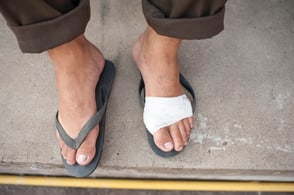 Ulcers are areas in which the skin has eroded, creating an open wound. They are often round and crater-like, may leak fluid or blood, and the skin around the ulcer may be red, inflamed, tender to the touch, and in some cases, very painful. Ulcers may affect just the surface layers of skin, or they can extend deep into the underlying dermal layers or even into the fat layer beneath the skin. The most common types of skin ulcers are stasis ulcers and pressure ulcers.
Ulcers are areas in which the skin has eroded, creating an open wound. They are often round and crater-like, may leak fluid or blood, and the skin around the ulcer may be red, inflamed, tender to the touch, and in some cases, very painful. Ulcers may affect just the surface layers of skin, or they can extend deep into the underlying dermal layers or even into the fat layer beneath the skin. The most common types of skin ulcers are stasis ulcers and pressure ulcers.
About Stasis Ulcers
Stasis ulcers, also known as venous ulcers, typically appear on the lower legs, on or near the ankle, or between the ankle and calf. They are caused by a condition called venous stasis, or venous insufficiency, which is characterized by pooling of blood in the veins of the legs. This causes abnormally high pressure inside the veins, which damages capillaries, allowing them to leak. Proteins that leak from the capillaries prompt an inflammatory process in the skin, called stasis dermatitis, that can lead to skin darkening, itching, scaling, and eventually stasis ulcers. Risk factors for the development of stasis ulcers are conditions that cause venous stasis and leg swelling (edema), including age-related weakening of valves within the veins, congestive heart failure, varicose veins, and blood clots.
Stasis ulcers generally require treatment by a wound care specialist, which may include periodic wound debridement – or removal of damaged tissues – to enhance healing; specialized dressings that may include films, gauze, foams and/or gels; and treated wound coverings. Oral antibiotics, topical steroid creams, and other medications to enhance healing may be prescribed as part of wound care as well, and in some cases surgical intervention, such as skin grafting or vein surgery, may be recommended.
Other treatments and therapies typically used in the management of stasis ulcers include compression therapy, most commonly using compression stockings or bandages, and a routine of elevating the legs above heart level for 30 minutes 3 to 4 times daily to aid in controlling edema and enhancing blood circulation. Medications and regular exercise – especially leg exercises – may also be used to minimize edema and improve blood flow, factors that are essential to efficient healing and recovery.
About Pressure Ulcers
Pressure ulcers, also called decubitus ulcers or bed sores, are most commonly caused by undue pressure on the skin over prolonged periods of time, reducing blood flow to the area and causing skin breakdown. These sores most frequently appear on the hips, back, ankles, and buttocks. Risk factors for pressure ulcers include prolonged time spent sitting or lying down, poor mobility, fragile skin, advancing age, poor nutrition, incontinence, and health conditions that affect proper blood flow, such as diabetes or cardiovascular disease.
Pressure ulcers, like stasis ulcers, typically require specialized wound care. This generally involves wound irrigation, debridement, and specialized dressings. Topical or oral antibiotics may be necessary to reduce bacterial contamination or treat wound infections, and techniques like vacuum-assisted closure may be used to aid healing in some cases. Pressure ulcers that fail to heal with use of these wound care practices may require surgical repair.
Management of pressure ulcers also typically includes use of support devices and frequent physical repositioning of the body when at rest to guard against pressure on wounds, pain management, and nutritional therapy and/or counseling. If incontinence is an issue, managing it aggressively is important to improving wound healing and may be done via frequent undergarment changes, scheduled toileting, protective skin care, and/or use of urinary catheters or rectal tubes.





